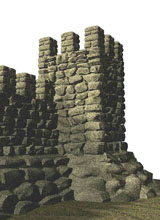 | Iluraton
|
|||||||
 |  |  |  |  |  |  | ||
 |  |  |  |  |  |  | ||
| Main page | ||||||||
|
[1] | [2] | [3] | [4] | [5] | [6] | [7] | [8] | [9] | [10] | Далее |
||||||||
| Vladimir Anatolyevitch Gorontcharovskiy Iluraton: A Fortress of the 1st- 3rd centuries AD on the European Kimmerian Bosporos | ||||||||
The 'Lower' necropolisThe presence of another necropolis (which has received a name 'Lower') to the northwest of the settlement was discovered only in the 1930s, when finds from graves in the territory of the modern village of Ivanovka began to arrive in Kertch museum. V.F. Gajdukevic, who carried out minor excavations here, having discovered two pillaged slab tombs, assumed that this was the main necropolis of Iluraton (Gajdukevic V.F., 1958, p. 138-139). Further regular excavation of the necropolis was not carried out. In 1968 M.M. Kublanov excavated three of eighteen burials found by local residents on personal plots in the eastern part of the village (Kublanov M.M., 1971, p. 84-85). After a long break, in 1988-1990, rescue excavations were carried out in the area under the supervision of V.A. Goroncharovski prior to the laying of a waterpipe and the construction of a school were carried out. Twenty nine burials were excavated which allowed a summary picture of this necropolis, that was in use from the first century till the first half of the 3rd century AD (Goroncharovski V.A., 1991, p. 14-16). The standard type of tomb dug into the clay soil was a stone box covered by several limestone slabs (Fig. 11, 3). Sometimes, they overlap the ditch cut into the natural clay. A westward orientation, sometimes with small deviations, is characteristic for the inhumations. The structure of the grave assemblage is similar enough. For male burials a long sword, dagger, and spear (Fig. 11, 4) together with a set of pottery for drinking wine are characteristic (Goroncharovski V.A., 1998, p. 85-89). In female burials, as a rule, there are beads of glass paste, cornelian, chalcedony or agate, a bronze mirror of Sarmatian type with a broken or a cracked reflector, sometimes bronze needle case, and about the legs glass vessels (Fig. 12, 2,3) and a red-slip bowl, or bowl of gray clay. Out of the ordinary are the finds of gold earrings (Fig. 12, 4); a silver ring with a garnet insert on which the image of Athena has been carved (Fig. 12, 5), and a glass ring made from twisted filaments yellow and white in colour (Fig. 12, 6).
Figure 11.
Figure 11.
There are also more complex constructions, for example, a robbed chamber tomb made of carefully joined, well-trimmed slabs (Fig. 12, 1). A small stepped dromos led to the burial chamber 3x3 m in size with the remains of a stepped vault. The chamber itself is generally rectangular in plan. On the corners and along the walls of the chamber the remains of not less than five human skeletons were found, which confirms the multiple use of the tomb. The uppermost courses of the chamber walls of the burial chamber walls stood above the contemporary level of the surface. So it is no doubt that the tomb would have originally had a tumulus mound above it.
Figure 12.
Figure 12.
Figure 12.
Figure 12.
Figure 12.
Figure 12.
Taking into account the size of the lower necropolis, the similarity of the greater part of the funerary constructions to one another, as well as the accompanying tomb assemblage, it is possible to assume that this site served as a place of burials not only for the inhabitants of Iluraton, but also for those of the nearby rural settlements. [1] | [2] | [3] | [4] | [5] | [6] | [7] | [8] | [9] | [10] | Далее |







